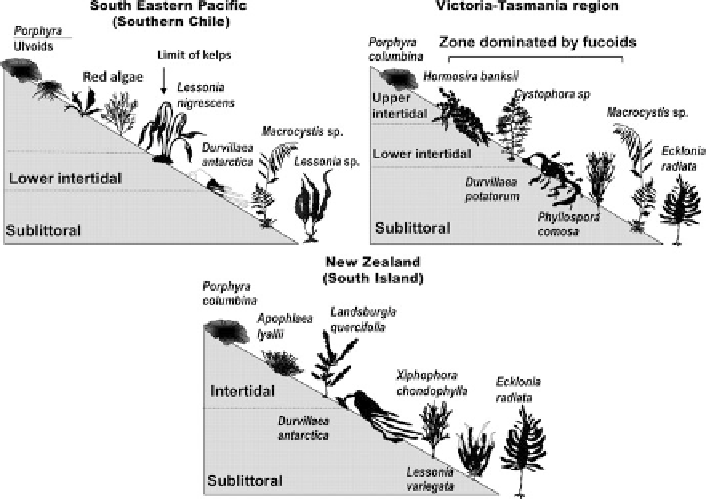Biology Reference
In-Depth Information
Fig. 14.2
General patterns of seaweed zonation, with dominant species in each littoral zone, in
southern Chile, Victoria-Tasmania, and New Zealand (South Island) (the schemes represent a
compilation of the literature revised in the text)
can colonize shaded pools and rocky crevices. The large kelp
Lessonia nigrescens
and the fucoid
Durvillaea antarctica
define the structure in the wave-battered
infralittoral zone together with crustose/articulate species (
Corallina
) and red
algae adapted to episodic erosion-accretion of sand such as
Ahnfeltiopsis
durvillaei
. The sublittoral zone (up to 10 m) is characterized by a heterogeneous
group with a dominance of kelps such as
Macrocystis pyrifera
,
Lessonia
trabeculata
,
L. vadosa,
and
L. flavicans
(Villouta and Santelices
1986
), mixed
with thin leathery red algae (e.g.,
Rhodymenia
sp. and
Callophyllis
sp.). Giant
kelp forests are also found in protected bays and fjords, while the rhodophyte
Gracilaria chilensis
dominates in estuarine zones (Santelices
1980
; Buschmann
et al.
2004
). At midlittoral and subtidal zones of the Magellan coast and some sub-
Antarctic islands south of Tierra del Fuego (e.g., Diego Ramirez Islands), some
species common to the Antarctic region (e.g.,
Adenocystis utricularis
,
Iridaea
cordata
,
Gigartina skottsbergii
,
Desmarestia
sp.) can be abundant (Santelices and
Ojeda
1984
; Westermeier and Rivera
1986
).
The coexistence of
L. nigrescens
and
D. antarctica
at infralittoral zones
conforms one of the most remarkable ecological associations. The spatial distribu-
tion and abundance of these two habitat-forming species result from complex
interactions and morphofunctional adaptations, both species exhibiting different
strategies to persist in areas with strong surf (Santelices et al.
1980
; Westermeier

